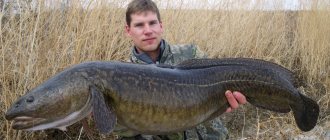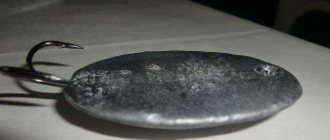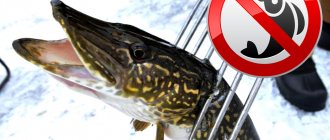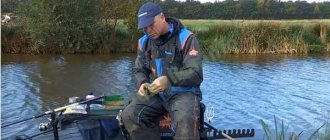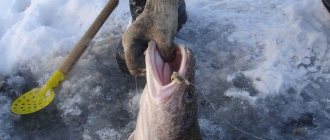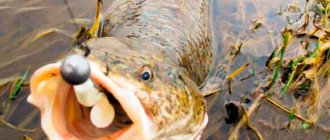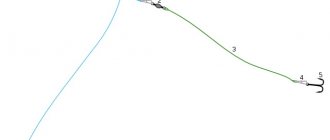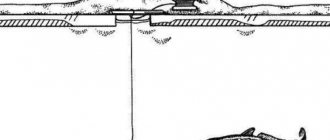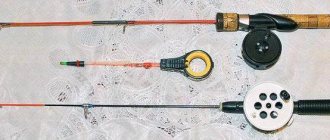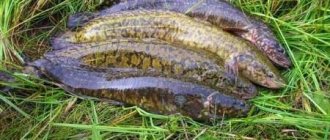Burbot is a desirable but finicky prey. In many reservoirs the number of cod fish is insignificant, so sitting around waiting for a bite can be too tiring and uninteresting. There is a way to improve the likelihood of catching fish by using passive gear - a reel. Burbot using a net is no worse than using active types of gear, but the fisherman only needs to install it and remove it in the morning. An additional advantage of the gear is the ability to be in a warm house or car, and not freeze in a rainy autumn or frosty winter.
What it is?
This tackle is a type of hook fishing net. It consists of a thick main rope on which long leashes with hooks are fixed. It is not difficult to install such tackle. The twine can be tied on both sides to guards (long rods, usually made of spring metal or polymer), which are also called bite alarms for bottom gear. Also, the main rope can be fixed to two snags protruding above the surface of the reservoir, to stakes driven into the bottom and other supports. The most important thing is that before installing the network, you need to determine which direction the water flows. This is necessary because the tackle is placed not along the current, but across it.
This net is used to catch not only burbot, but also other large predators, for example, pike, catfish, and pike perch. The harness can be used both in summer and winter, fixing the main rope on the ice.
Rice. 1. An example of installing a saddle.
How to catch burbot
The range of gear for catching burbot is varied and unpretentious. Squealers, jigs, donks, and fishing rods with a spinner or heavy jig are used. All of them are effective with the right approach and choosing the right place and time of day.
For girders and supplies
This type of fishing is especially popular in winter due to its effectiveness. The design can be purchased in a store or made with your own hands. It consists of:
- round or square base;
- spools of fishing line;
- racks;
- springs with a flag.
The rod is installed according to the diameter of the hole, a spring with a flag fixes the reel, preventing the bait fish from pulling off the fishing line. When a predator swallows prey, the alarm shoots upward. Thanks to this, you can quickly notice the catch and approach the triggered girder. It is worth paying attention to the movement of the coil. If it unwinds slowly, it means the burbot has not yet captured the bait and is holding it in its teeth. Rapid and constant unwinding indicates that the fish is hooked.
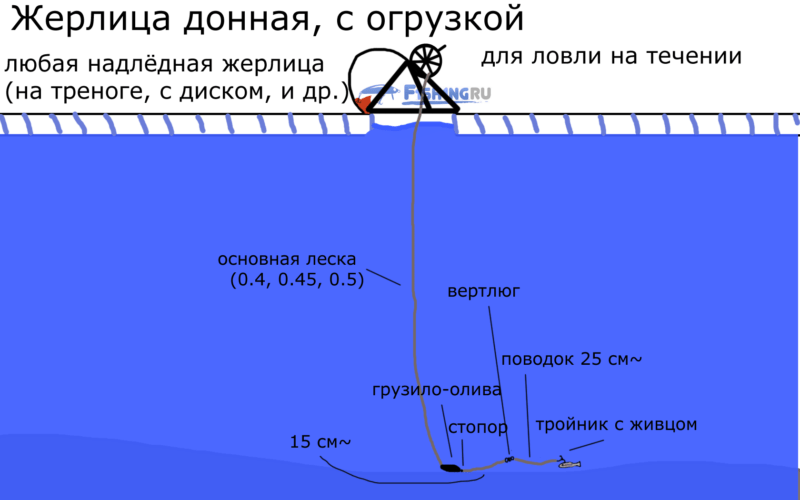
Variant of the donkey-jerk
Since fishing with girders is long-term fishing, you can install it at night and check the catch in the morning. To do this, you should choose a fishing line that is not too long, so that the burbot does not go far and get tangled in snags. Usually about a dozen holes are set up at night, and the bases are covered with snow so that the holes do not freeze. Various fish are used for bait; burbot bites on almost any bait.
Postavushka is a type of girder that is installed under the ice. It can be made at home. The design consists of a fishing line, a sinker, a leash and a spacer, which is installed across the hole. For bait, preference is given to live bait (ruffe or gudgeon), pieces of fish, worms or seafood.

What does a delivery from ice look like?
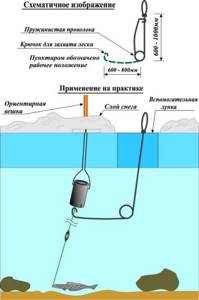
This scheme is used mainly for catching pike, but burbot can also be caught effectively. Live bait is often used as bait. Simplified version of delivery, underwater diagram
Winter supplies, unlike ordinary vents, are not equipped with a bright flag, so their location must be marked for quick detection. Holes with deliveries are located at a distance of 10 meters from each other. To prevent the tackle from being carried away by strong currents, it is necessary to select the sinkers correctly. The fishing line for such gear is usually thick - 0.3-0.4 mm .
Catching burbot with a jig, video
Watch the video:
On the jig
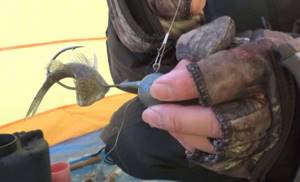
Jig is another common type of fishing that fishermen use to catch burbot in the winter months. This is due to the simplicity of the design and the fact that fish can be attracted with ordinary artificial bait.
For catching burbot, a relatively large jig with a large and strong hook is suitable. the fishing line should be thin, and the fishing rod should be flexible but rigid, because when hooked, the burbot exhibits strong resistance and it will be quite difficult to pull it out.
Fishing for burbot will be successful with the right tactics. To do this, you need to lower the jig to the bottom to create a cloudy cloud that will attract burbot. After this, you should raise the jig higher and make several forward movements, then lower it to the bottom again. There should be as many such falls of the jig to the bottom as possible. The frequency of movements is 0.5-1 seconds.
Winter migration for burbot
A saddle is a structure consisting of a long rope stretched between weights and supplied with several leashes with hooks. One or more types of bait are attached to them. Fishing enthusiasts prefer this type of fishing for trophy entry.
How to set the switch? The barriers are installed directly under the ice. To do this, an ice hole and several holes are cut on the same line with a distance of approximately 2-3 meters. A pole with a tied rope is lowered into the hole, which is pulled between the holes using a hook. Then the rope is tied to the saddle and hooks are baited onto it.
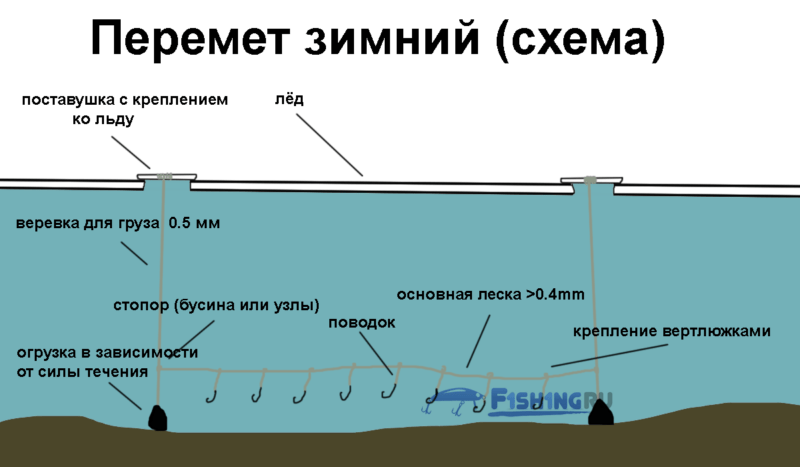
Another option for how to set a line is an under-ice winch, or popularly called “cuttlefish”. It consists of a large drum, a cord wound around it, and gears with jagged edges that easily cling to the ice. The design is quite light, has buoyancy due to plastic parts, and allows you to stretch the cord over long distances.
The following are used as baits:
- various types of live bait (ruff, ide, gudgeon);
- insect larvae;
- seafood;
- shell meat.
Installing a fender on the current, video
Fishing with spinners, snooker
Classic nod for pike perch
When fishing for burbot in winter using a spinner, a hard nod is used, which is equipped with a minimally simple reel with a stopper. When a large specimen bites, remove the burbot from the water by the fishing line, measuredly but quickly.
To increase the chances of success , the bait can be shaken or tossed rhythmically, pausing periodically for less than 1 second. Burbot is attracted not so much by the movement of the spinners as by the sounds made. Therefore, it is important that the bait falls to the bottom with a sound. Some fishermen complement the lure with special elements that create a tinkling sound.
snitch fishing . Outwardly, it resembles a balance beam because it has hooks protruding from both sides. To make a knocker, you can use unnecessary weights into which hooks are inserted on the sides. For greater weight, you can make a special mold with lead poured into it. The knocker should not be too heavy, otherwise it will not make any noise when it hits the bottom.
You need to attach bait in the form of cut fish to the hooks. The pieces should be large, the size of a walnut. The technique is performed as follows: the bait falls to the bottom with a knocking sound, rises and falls again. Usually it is this method that the burbot evaluates especially actively. It is unknown what attracts him more - pieces of fish or strange sounds.
Catching burbot by knocking, video
How to use it to avoid problems with the law?
If you don’t know how to set the line correctly, problems with fisheries inspection may arise. This gear will be considered poaching. Primary requirements:
- You cannot set hooks without bait, incl. samolovy. This will be considered poaching.
- Do not use nets with more than 10 hooks.
Usually these rules are violated by fishermen who make their own nets. Manufacturers of this gear know the law, so in fishing stores you can only find those nets that meet all the requirements.
Features of tackle for burbot
A bottom fishing rod for burbot does not have any features that would radically distinguish it from a bottom fishing rod for other fish, since the specifics of fishing are identical. The main feature is the use of a thicker fishing line (0.4-0.7mm), but less long than when catching other fish.
The point is that there is no need to cast far. As a rule, bottom tackle has a length of no more than 10-15 meters. A sinker and a pair of leashes, 30-35 cm long with a fishing line with a diameter of 0.2-0.4 mm, are attached to the main line. All tackle is attached to a reel of any shape, made of any available material: wood, plywood or plastic.
Manufacturing
Recommended viewing:
To make a burbot catch with your own hands, you need to prepare the materials in advance:
- main rope or fishing line with a cross-section of at least 0.5-0.7 mm (its length depends on the number of hooks, but not less than 5 m);
- sinker weighing 100-250 g;
- leashes with a cross-section of 0.2-0.4 mm (length depends on the depth of the reservoir);
- hooks No. 6-8 (no more than 10 pcs.);
- swivels (a device that prevents the line from twisting).
Expert opinion
Valery Andreevich Sizov
Professional fisherman with 35 years of experience
Note! To make a saddle, you can use single, double and even triple hooks. They are all suitable for catching burbot. However, it is important to take into account that the predator very often grabs the bait deeply, so it is better to choose models with an extended fore-end.
Step-by-step production of a classic saddle:
- Attach a sinker to one end of the fishing line or rope.
- Step back about 45 cm and make a loop.
- Attach a swivel to it.
- Place a leash on it with a hook at the end.
- Repeat these same steps until the end of the main line or rope. The distance between the swivels must be at least 1 m. The main thing to remember is that you cannot place more than 10 hooks. This means there can be a maximum of a dozen leashes.
- After completion of the work, at least 5 m should remain from the outermost first hook to the guardhouse at the other end.
- Secure one end (without a sinker) to the shore, and the other to a support in the reservoir.
- If there are no more than 3 leads on the main rope or line, then casting can be done manually. When there are more of them, you will have to use a boat to place the line or enter the water yourself.
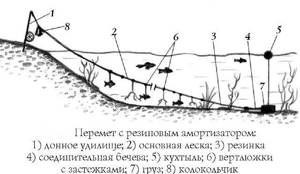
Rice. 2. The tackle can be modified and equipped with a bell (bite alarm) and a hook (used as a float).
Rules for installing a burbot saddle
Open water installation method using a boat:
- We load the prepared gear into the boat and sail to the opposite bank (if the width of the riverbed allows you to install the full size of the gear).
- We secure the tackle on the shore with a peg.
- Gradually, swimming towards the original shore, we release the fishing line and leashes. As we approach the leash, we attach live bait to it: pieces of fillet or dead small fry from the same reservoir.
- We fasten the fishing line from the second bank with a peg.
Installation method in winter on ice:
- We make holes, retreating 6-8 m between them, and run a rope through them (run).
- We attach a harness to the run with a fixed weight at the end, which we equip with bait as the tackle is lowered.
- We tighten the tackle so that it is placed more evenly on the bottom.
- We fasten the line to the pegs and freeze them in ice in advance.
Important! It is better for 2-3 fishermen to go fishing in winter, otherwise the tackle will get tangled, and the fisherman will take a long time to bait baits. After installing the gear, we leave it until the morning. When the sun comes out, it's time to check for the catch.
There are some useful tips from experienced fishermen to help you install the tackle correctly:
- an excessive number of hooks can only damage the gear. A line with ten hooks begins to get very tangled, so the casting process becomes more complicated. Ensuring the safety of the bait also becomes difficult;
- the optimal number of leashes at the shoreline is 3 pcs;
- In the current, it is better to install the tackle across the direction of the water. Shore tackle is easy to cast if you select the correct size sinker. It is better to bring tackle from a boat if the burbot is at great depths (installed experimentally or using an echo sounder);
- on small rivers the fencing is stretched across the entire width of the river, securing the tackle on both sides with pegs.
Installation Rules
Before you go to set the line, you need to familiarize yourself with the weather forecast in advance. Burbot bites better when:
- changes in atmospheric pressure were recorded;
- windy weather;
- it's raining;
- moonless night.
How to quickly install tackle when there is a boat:
- Considering that the net is not placed along the current, but across it, sail from the shore in the required direction.
- Drive a peg into the bottom or secure one end of the main line/rope to any other support.
- Swim back to the shore, gradually lowering the leashes into the water, not forgetting to attach bait (live bait or meat/fish pieces) to the hooks.
- Secure the other end of the rope/line to a guardhouse or peg fixed on the coast.
Expert opinion
Valery Andreevich Sizov
Professional fisherman with 35 years of experience
Note! When installing the gear, it is better to have 2-3 people present . If it is set by one person, it may get confused. In addition, it will take more time to place the bait.
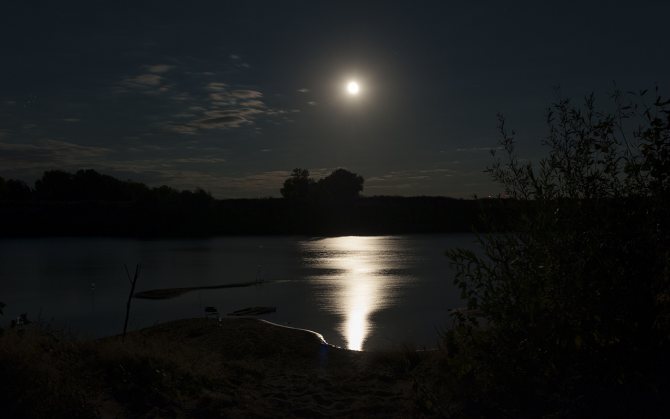
Rice. 3. The tackle can be installed at dusk and returned for it in the morning. Even if the burbot stays on the hook for several hours, nothing will happen to it during this time.
Method of installing the saddle in winter:
- Make several holes at a distance of 5-8 m from each other.
- Attach a crossbar to the purlin or a special wire hook (the length of these devices should be similar to the distance between the holes in the ice).
- Sequentially placing bait on the hooks (live bait, pieces of meat or fish), stretch the tackle using a run or wire hook from hole to hole.
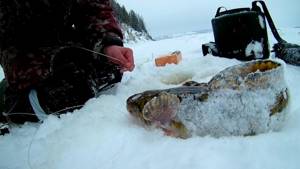
Rice. 4. Unlike many other fish, burbot is active in winter, so even trophy specimens can be caught on the line.
Catching burbot using a line
Fishing involves cold, rain, pressure changes, night. Burbot really likes bad weather, but it’s nice that you can set up the gear in the evening and go check it early in the morning, after waiting out the unpleasant weather in a tent or at home.
The search for a trophy differs depending on the time of year:
- In winter, burbot stays near the bottom during the day, in snags, stones, and often stands on riffles. At night it goes aground to hunt in coastal areas.
- In summer, the predator is generally inactive during the day. It stands in holes at great depths, in channels of cold water, and comes out to hunt only at night. It hides under trees, dumps, and swims briefly to the shores, waiting for prey there.
We recommend reading: What is a shock leader: (description of an important element when fishing for carp)
Important. To set a line from a boat, you can throw a load at the desired fishing point, and tie the end of the tackle to a bottle or polystyrene foam. Then sail to the required distance and repeat the procedure.
Installation from the shore occurs in such a way that the end of the tackle is thrown as far as possible. The beginning is attached to a stick or rod and is firmly fixed.
It is better to go winter fishing with lines together.
The installation procedure is as follows:
- A promising fishing location is selected.
- Holes are drilled in a line with the same spacing so that there is enough hook. This is necessary to hook the rope from one hole to another, as a rule, this is every 2 meters. Thus, the tackle is launched at the selected distance under the ice.
- The end sinks to the bottom.
- On the other hand (at the beginning), a stake is driven into the ice, and all the gear is tied to it.
- It is advisable to cover the holes with snow to prevent them from freezing with ice, and mark them so that you can find them in the morning.
Note! As a rule, it is better to leave the litter overnight, as this is when the predator is most active.
It is not difficult to get it by using a tied rope with a bobbin that was left on the ice under the snow or a hook by the main rope under water.
Vendors and supplies
Some fishermen call this gear a girder, others a stowaway. In fact, they are the same thing (in a broad sense). This is a kind of tackle that is equipped with live bait and left in the hole for a certain period of time. There are a huge number of options for implementing gear; you can also invent something convenient just for you. A burbot trap can be made from scrap materials; ordinary flags that are used for pike fishing will do. Supplying burbot does not require any special refinements. It should be durable, reliable and comfortable.
Winter perches for burbot do not need to be equipped with alarms - the predator is detected itself, so this question is not for everyone. If you are actively fishing and immediately react to bites, equip your gear with alarms. If you left it until the morning, the flags, in principle, are not needed. If you don’t want to bother too much, buy regular cheap pike flags at a fishing store; they’ll work just fine. Just check that the reel is normal and that the plastic circle for the hole does not break under strong jerks. Wind 0.3-0.4 mm fishing line onto the reels, you don’t need much, 10 meters is enough.
Homemade girders and supplies
You can assemble a simple supply for burbot with your own hands in winter. How to properly make a winter bait for burbot? There are no strict rules, the main thing is that the tackle works. Let's look at the most common options that have been working effectively for years. In principle, there is no need to invent anything else - these tackles work great in any conditions.
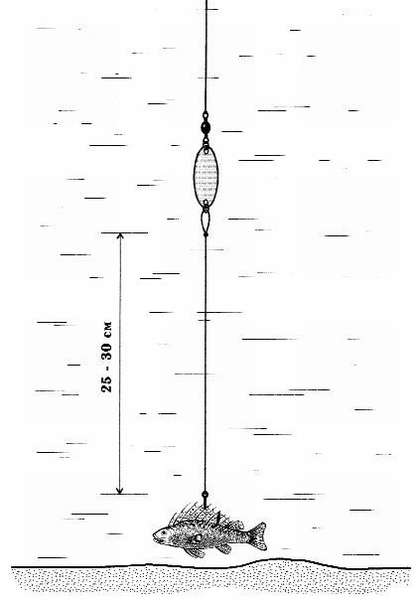
Kolobashka
To make a bait for burbot, you need to firmly attach and wind a piece of fishing line on the reel. The reel itself is attached with a piece of strong cord to a crossbar, which lies on the ice above the hole. It is necessary to provide a split on the reel in which the fishing line is clamped (to set the working depth). When biting, the line should come out of this split and reel in when the fish pulls. Having reeled in all the fishing line, the fish will hook itself. The reel is completely lowered into the hole, so it does not freeze, because only the crossbar and the cord remain outside. What exactly should I use as a reel? Our grandfathers made it from wood, and it was called “kolobaska”. Now, for example, it is very convenient to use a plastic yogurt bottle. Any design will do, as long as it works. 10 minutes - and the do-it-yourself burbot stand is ready.
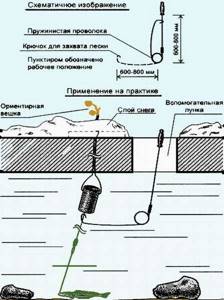
This type of gear can be installed throughout the winter. The crossbar with the cord will freeze into the ice, the stand will last the entire freeze-up. You need to check it through another hole drilled nearby, catching the fishing line with a special hook from under the ice. It is with this type of gear that Siberian fishermen catch burbot. You can see how this happens in the video:
Poking
The simplest tackle is a poke. 1.5 - 2 meters of fishing line is tied to a pole, the length of which allows it to be stuck into the bottom so that part of the pole sticks out of the hole. We equip the poke with a sinker, a hook and live bait, and lower it into the hole. We won't lose the hole because of the protruding part of the stick. That's it, the simplest tackle is ready.
Zherlitsa-anti-freeze
The poke and kolobashka are more suitable for anglers who constantly go out to catch burbot in the same places, or for multi-day fishing. These tackles, using such a simple folk method, avoided the problem of the equipment freezing into the ice. For city dwellers, a different solution is needed. In mild frosts and short fishing trips, a regular pike flag will do just fine. If you need to leave the supplies until the morning, and even in severe frost, then you need to take care that the hole does not freeze. Of course, you can patiently and carefully break the frozen hole with an ice pick. Or you can build a special screen that will not allow frost to freeze the hole overnight.
Now it is very convenient to use for this purpose a sheet of foam plastic with a hole (slot) for the fishing line, on which a regular flag is installed. You can also screw some kind of box on top so that the reel doesn’t get covered in snowstorms, and burbot bites best in the most disgusting weather. When installing, the sheet is sprinkled with snow on all sides. This way the hole is protected from freezing. In general, always think about the issues of comfort, warmth and nutrition when winter fishing. The fisherman should be comfortable, dry, and safe. Otherwise, your favorite hobby can turn into torture.
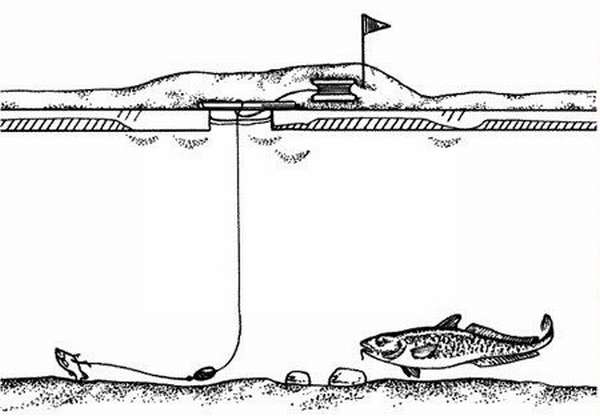
Correct equipment for burbot fishing rods
The rigging of a burbot rig in winter seems to be simple. You can tie a hook to the end of the fishing line, having previously installed a stopper and a sliding weight on it, and, in principle, the tackle can be used. But experienced fishermen always take into account the little things. It’s the little things in fishing that are the key to success. There is even a saying: “There are no trifles in fishing.” Despite the fact that the tackle for burbot is quite rough, these features should not be missed.
- The hook should be large enough, but not very large, otherwise the bait will die prematurely and attract burbot worse. It must also be durable and sharp. Always use only good and high-quality hooks, preferably with a long shank - this will make it easier to pull it out of the fish’s mouth.
- The length of the lower leash is selected based on fishing conditions, but on average it is from 0.5 to 1.5 meters. A special leash is not needed; it acts as a continuation of the main fishing line. From time to time it is necessary to check the integrity of the fishing line and the hook attachment point. If necessary, change the line or tie the knot. If fishing takes place in a cluttered place, then it is better to place a heavy sinker, lowering it to the very bottom, and make the leash about 30 centimeters so that the bait fish cannot insert the tackle into the nearby grass.
- If the fishing conditions allow for the strength of the current and the cleanliness of the bottom (no grass or snags), you can further improve the tackle by matching the weight of the sinker to the size of the bait so that it can occasionally lift it above the bottom. Then, when falling back to the bottom, the weight will make a knocking noise, which in turn greatly attracts burbot. Additional turbidity will also rise, which is also interesting for the predator. In this situation, the tackle must be installed not as usual - not reaching the bottom 10 centimeters with live bait, but placing the sinker directly on the bottom. In this case, the leash does not need to be made too long, 0.5-0.6 meters is enough.
- The stopper for the sliding weight can be made movable, thus making it possible to set the required length of the leash in place without redoing the equipment.
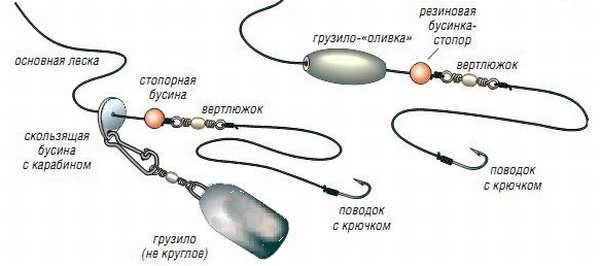
Strong Current Rig
Sometimes you have to catch burbot using girders in a fairly strong current. In this case, a different installation of equipment is suitable. One option for rigging a girder for burbot in winter on the current is the same as usual - a sliding weight on a fishing line. Only in this case, the load must be heavy, so that it is not carried away by the current. A fish that bites will still wind the line freely, since the load is sliding. Another option is a blind weight at the end and a long retractable leash with live bait. Which gear is better and more convenient is up to the fisherman to decide directly on the pond.
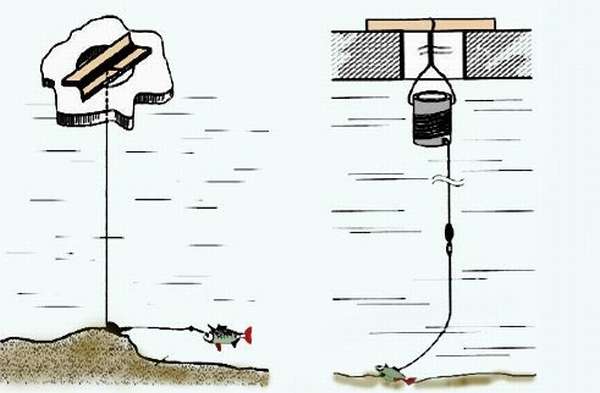
The right bait for burbot
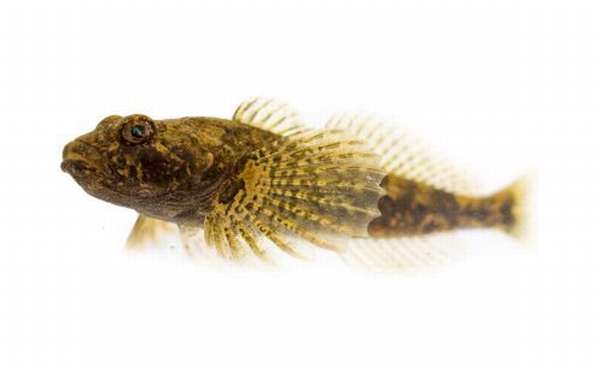
When catching burbot using bait in winter, you must use live fish as bait. To attach live bait to a burbot in winter, standard methods are suitable - by the back in the area of the dorsal fin, or by the lower lip or through the nostril. The first method is most often used. It is also good because when a fish is attached, a wound is formed at the puncture site, through which particles of blood penetrate into the water, which in turn attracts burbot also by its smell, and this predator has an excellent sense of smell.
An important issue is the choice of fish species as live bait when fishing for burbot. According to numerous observations, the most favorite fish for burbot is the loach. Burbot always takes it. You can get loaches using special lifts through an ice hole, attracting them there by supplying air bubbles, for example, with a compressor. For some reason, loaches gather on these bubbles. It is almost never possible to catch it with a fishing rod in winter.
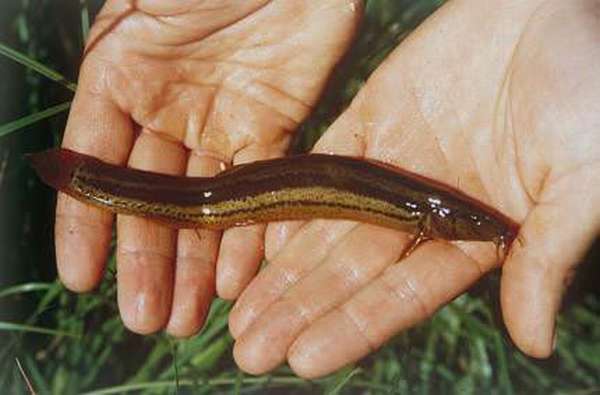
If there are no loaches, then the best bait will be a ruff, which often forms the food supply for burbot. It is also good because it is quite tenacious on the hook of a girdle, and it is much easier to catch ruffs on a fishing rod than loaches.
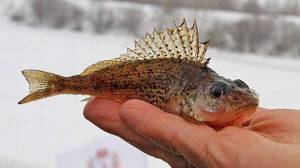
Perches, gudgeons and sculpin gobies, or, as they are also called, broadheads, are good bait for burbot. If this is not the case, then feel free to hook any live fish that you have. Minnow, roach, crucian carp - everything is suitable. As a last resort, you can equip the girder with a dead fish or sliced fish, a shrimp, a piece of liver - a predator often takes such a nozzle. But it will still be better if you use live fish.
